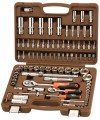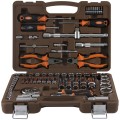Total number of items
The total number of core items included in the set.
In this case, the main items are all devices that are directly used during work: non-separable tools (traditional wrenches, hammers, pliers ...), elements of collapsible tools (for example, a ratchet for removable heads and 5 such heads will be considered 6 units) , as well as accessories (such as extensions or universal joints). Additional accessories — such as lights — may or may not be included in this count, depending on the manufacturer; however, there are usually few such accessories, and they do not fundamentally affect the total number of items.
The most modest modern tool kits include
up to 25 units. However, such kits are very popular — they are inexpensive and at the same time can be very versatile.
25 – 50 items is still quite a small number,
50 – 75 pcs can be called an average,
76 – 100 items are more than average, and the most extensive modern sets can include
100 – 150 items or even
more.
The general rules for choosing this parameter are obvious: a more extensive set, usually, is more multifunctional, but more expensive, weighs more and takes up more space. It is also worth bearing in mind that with a similar number of items, the specific assortment of these items in differ
...ent sets may be different; so when choosing, it is worth specifying not only the number of tools, but also their specific composition.Bits
The number of
bits supplied with the tool kit.
A bat in this case is called a working nozzle, which plays the role of a screwdriver tip; in fact, they are most often used with screwdriver handles (see above).
Many types of splines (slots) are used in modern fasteners — starting with the well-known
straight, cross-shaped (
Phillips and
Pozidriv),
Torx sprockets and ending with exotics like Torq-set (a cross with lines shifted from the centre), Pentalobe (with five ledges), etc. .P. In addition, the size of the slots can also vary, and in many cases, tool matching in size is very important. Accordingly, the more bits supplied with the set, the more versatile it is, the higher the probability that it will contain a nozzle of the desired type and size. However, the specific list of bits in the kit also does not hurt to clarify — in order to make sure that it has all the varieties you need. In the characteristics of individual sets, these data are given in the paragraph "Bit sizes" (see below).
Hex wrenches
The number of
hex wrenches supplied in the kit. Note that some modern kits include
only hex wrenches, without any other fixtures or accessories. It is also worth emphasizing that in this case we are talking about the simplest hex wrenches. Imbus tools — similar in purpose, but different in design — are highlighted in our catalog in a separate category (see below),
Keys of this type usually have the form of L-shaped handles made of a hexagonal rod. Thus, the user can work with both the short and long side of the key; in the first case, the long part of the letter "G" works as a lever, providing a good effort, in the second — it plays the role of an extension. And such tools are used for bolts and other similar parts with a hexagonal cut in the cap. Such splines have a number of advantages over the classic straight and cross splines (in particular, better tolerating high torques), which makes them quite popular — in particular, in bicycles.
As for the quantity, it is worth considering here: sets with the same number of keys of the same type may differ in the specific sizes of these tools. Such nuances should be clarified before buying separately.
Hex wrenches size
Working size range of hex wrench sizes (see above) supplied with the kit. This parameter allows you to evaluate how the keys fit the dimensions of the fasteners with which they are planned to be used.
Screwdriver
Number of classic
screwdrivers supplied in the kit. Note that some modern tool kits include
only screwdrivers, without any other fixtures or accessories.
Despite the proliferation of screwdriver handles with interchangeable bits (see above), traditional non-separable screwdrivers also remain popular nowadays. One of their advantages over collapsible counterparts is the convenience of working with different types of fasteners at the same time: keeping several separate screwdrivers with different sizes and types of tips on hand (for example, two flat and two cross-shaped ones) and taking a tool as needed is much more convenient than constantly changing bits on the screwdriver handle. Other advantages include strength, reliability, as well as matching the size of the handle to the size of the tip and the expected features of the work. So, screwdrivers for large fasteners are equipped with thick handles that allow you to develop a lot of effort; and with small tips, handles of small thickness are used, contributing to precision and accuracy.
As for the quantity, it is worth considering here: a larger number of screwdrivers gives more opportunities, however, the specific set of such tools (and opportunities) in different kits may be different. These details will not hurt to clarify before buying. Also note that it hardly makes sense to look for numerous screwdrivers for simple work — in suc
...h cases, a handle with bits may be more convenient.Pliers
Number of
pliers supplied in the kit.
Initially, pliers are a device for holding, manipulating and squeezing various parts, having two handles and two characteristic flat jaws (hence the name). However, in the case of tool sets, this term often means a more functional device — pliers. Modern pliers, in addition to the flat part, have the following equipment:
— one or two recesses on the jaws, allowing you to capture pipes and other round / polyhedral parts;
— a pair of blades that allows you to use the tool as wire cutters;
— devices for cutting wire from the outside of the jaws (usually on both sides).
In most modern tool kits, only one pliers are provided, and, usually, these are pliers — thanks to the extensive capabilities of such products, such equipment is most often quite sufficient. However, there are also exceptions to this rule. In such cases, additional pliers can be both smaller pliers and other types of tools; this point should be clarified separately, and the options may be as follows:
— actually pliers of a traditional design, without additional equipment;
— thin-nosed pliers with long, elongated jaws, well suited for delicate work;
— round-nose pliers — with round-shaped jaws, used, in particular, for bending wire and other parts.
Wire cutters
The number of
wire cutters supplied with the tool kit.
Nippers are used for cutting (biting) metal parts of relatively small thickness — for example, wire. There are several types of this tool, but the most popular are the so-called side cutters. The principle of their design is similar to pliers, however, when you press the handles, it is not flat sponges that are compressed, but sharp cutting edges.
This tool is very versatile: standard wire cutters are quite capable of coping with almost all tasks for which such a tool is, in principle, used. Therefore, even very extensive tool kits are usually completed with just one wire cutter.

